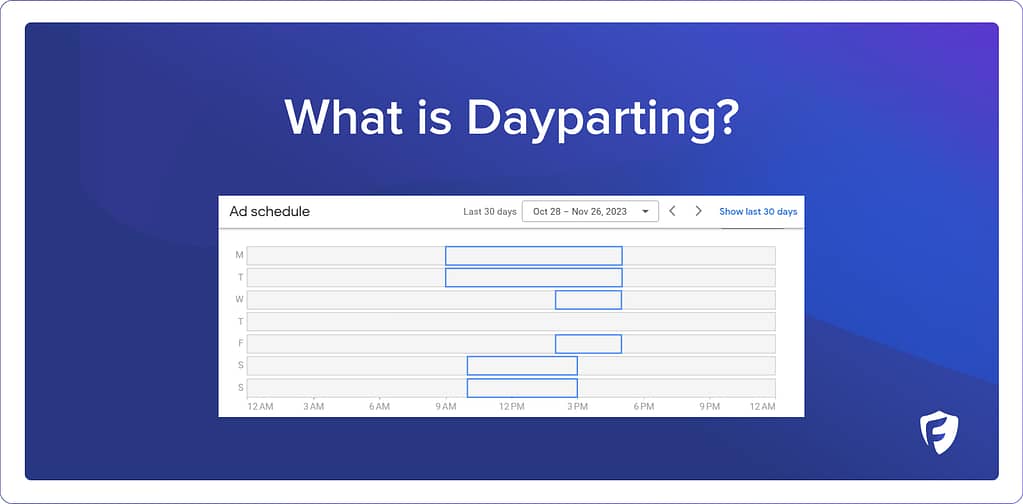What is dayparting?
Dayparting segments the day into different parts and allows advertisers to schedule and bid differently for each part at the most opportune moments.
For instance, a breakfast product ad might perform better in the early morning, while entertainment-related ads might see more engagement during evening hours. By aligning ad schedules with user activity patterns, businesses can significantly increase the effectiveness of their campaigns.

Why is dayparting important?
Dayparting ensures that ads are not just seen but seen by the right people at the right time. This timing can make a substantial difference in campaign performance.
For instance, advertising leisure products during work hours might not yield as much engagement as advertising them during leisure hours. Therefore, understanding and implementing dayparting strategies becomes pivotal for maximizing ad reach and relevance.
What are the benefits of dayparting?
The benefits of dayparting are numerous. Primarily, it leads to more efficient use of the advertising budget, as ads are shown when they are most likely to be effective. This efficiency can lead to higher click-through rates and conversions.
Additionally, dayparting helps in understanding customer behavior patterns, allowing for more targeted and personalized advertising strategies. It’s a step towards creating a more user-centric advertising experience, which is increasingly valued in the digital age.
Dayparting strategies
To use dayparting effectively, it’s important to have a clear understanding of your target audience’s online behavior. Utilizing analytics tools to track when your audience is most active online is a good starting point.
Strategies may include identifying peak activity times for your target audience, considering time zone differences for a global audience, and experimenting with different time slots to gauge performance.
It’s also essential to align the content marketing with the time slot. For example, ads promoting relaxation activities might work better in the evening, while ads for productivity tools could be more effective during morning hours.
It’s also important to consider aligning your dayparting with other marketing channels. Email blasts and social media posts should correspond with peak activity times to enhance open rates and maximize social engagement rates.
What are the challenges of dayparting?
One of the primary challenges is the need for accurate data and analytics to determine the optimal times for ad placements. If you believe the morning leads to the best time for focusing your ad spend and you misread the data, then you will be wasting your ad budget more quickly.
There’s also the risk of narrowing the audience too much, potentially missing out on broader outreach opportunities during other dayparts. Additionally, combining dayparting with frequency capping is essential to avoid ad fatigue—showing ads too frequently within a short time frame can lead to diminishing returns.
Balancing specificity with reach requires careful planning and continuous optimization.
Common dayparting mistakes
Common mistakes in dayparting include failing to account for time zone differences, not updating dayparting schedules regularly, and not aligning ad content with the appropriate time slot. Another mistake is neglecting to analyze performance data to refine dayparting strategies continually.
Avoiding these pitfalls is key to leveraging dayparting successfully.
How do seasonal trends affect dayparting?
Seasonal trends play a significant role in dayparting. Consumer behavior varies during holidays, festivals, and even weather changes, influencing when and how they interact with ads.
For instance, ads for summer products will likely perform better during warmer months. Similarly, e-commerce ads might see increased engagement during holiday seasons.
You should consider adjusting your dayparting strategies to align with these seasonal trends for optimal results.
What are some common dayparting terms?
Common terms include:
- ‘Peak hours’: the times when your target audience is most active.
- ‘Ad scheduling‘: the process of setting up ads to run during specific times.
- ‘Impression windows’: the time frames during which ads are likely to make the most impact.
What future trends are emerging in dayparting?
The rise of mobile usage has significantly influenced dayparting strategies. People use mobile devices throughout the day, often in different ways than desktops or laptops. This means advertisers must consider mobile-specific behaviors, like increased evening and late-night usage, when planning dayparting schedules.
AI and machine learning are expected to offer more precise audience insights, enabling even more targeted and effective dayparting strategies.
Lastly, the increasing emphasis on privacy and data protection will likely shape how dayparting is implemented, with a focus on ethical and responsible advertising.




